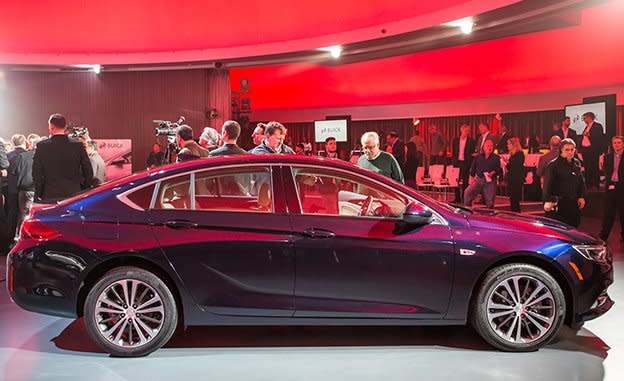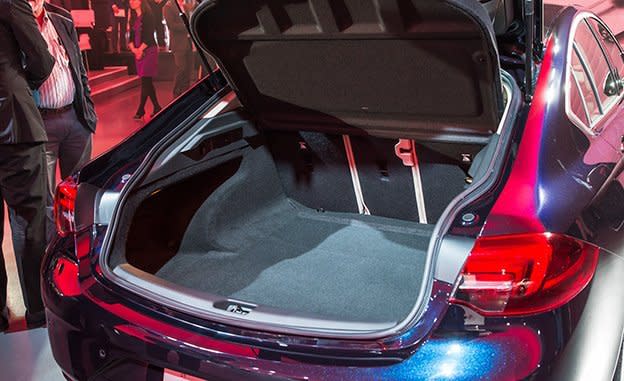2018 Buick Regal Sportback: Bye Bye, Sedan; Hello, Hatchback

Buick’s new Regal and the Audi A4 seem set on a collision course. It has been a long time—maybe not ever—since we could have typed any sentence that buoyed a Buick into the same conversation as Audi, but the all-new 2018 Regal works hard to ensure this is no false equivalence. For proof, check out the slick new body, classy interior, and sporty intent.
That’s a Buick!
We’re zeroing in on the potential Buick-on-Audi showdown because, on vanity alone, the two are the most visually desirable sedans in each other’s orbit. The 2018 Regal outsexes the dowdy Acura TLX and the somewhat awkward-looking Lincoln MKZ. We haven’t seen the upcoming S60 replacement, which, given Volvo’s recent design renaissance, could be quite a looker, but the current one borders on innocuous. This all leaves the Regal on an aspirational trajectory to the A4’s constellation, considering that the Audi (which also competes with the rear-drive BMW 3-series and the Mercedes-Benz C-class) has humbler front-drive-based roots similar to the Buick’s.

Maybe we should specify which A4 the Buick is taking aim at. The Sportback in the new Regal’s name is a nod to its large liftgate that takes the place of a traditional trunk. This means the Regal is technically a hatchback, albeit one that mimics a sedan in a way that’s reminiscent of the A4-based A5 Sportback, which coincidentally is headed for the U.S. market later this year for the first time. Boldly, Buick won’t offer a sedan at all, although it will chase another A4 variant, the lifted Allroad station wagon, with the Regal TourX.
By now everyone should be accustomed to Buicks that appeal to sub-octogenarians, so the Regal’s sleek look should come as no great surprise. Its subtly furrowed headlights, clean new winged grille motif, and delicate creases defining shoulder lines that run from behind each front wheel to the trunk are a vast improvement over the somewhat lumpy current model. And the four-door’s wheelbase has grown 3.6 inches to 111.4, while its overall length swells by 2.7 inches, shrinking the front and rear overhangs and improving the Regal’s proportions.
The lengthened wheelbase also pays dividends inside, where the new Regal’s back seat is more human-friendly than its predecessor’s relatively tight quarters. Buick fits a 60/40 split-folding rear seat as standard, although a 40/20/40 bench is optional for those who must have more flexibility. Unfortunately, when folded, the rear seatbacks sit higher than the cargo floor, creating a slight lip that prevents cargo from being slid in one go from the bumper all the way to the back of the front seats. The space in back is still markedly more usable than any similarly sized sedan’s trunk, and Buick claims that with the seats folded, there is 61 cubic feet of cargo space. Not to mention the flexibility afforded by the wide liftgate opening.

Beyond its bootylicious surprise, the Regal steps up the rest of its interior game big time for 2018. Inside, muted design is married to upscale materials and color schemes that put the outgoing car to shame. Higher trim levels feature a digital gauge cluster and a glossy 8.0-inch IntelliLink touchscreen that’s integrated better into the cabin’s aesthetic than are similar displays in other General Motors products. A 7.0-inch touchscreen with a similar menu structure is standard. Keeping up with the industry Joneses, Buick upgrades the Regal’s options sheet with the latest active-safety features such as automated emergency braking, lane-keeping assist, and adaptive cruise control.
At this point, our only major complaints about the interior are that the push-button starter is sort of hidden behind the steering wheel’s rim, and the air-conditioning controls are mounted slightly too low on the dashboard, just ahead of the shift lever, to be easily reached. Also, although nice, the cabin doesn’t quite rise to the exterior styling’s level, nor does it make a compelling design statement the way Audi’s A4 screams “modernism” or Benz’s C-class shouts “classy!”
Anglo-Saxon, Again
As it was before, the Regal is more or less a rebadged Opel Insignia, a German sedan sold in Europe. Even so, the Regal has a sibling local to the United States: Chevrolet’s latest Malibu. The two share some underpinnings and their wheelbase dimensions, and just as the Malibu lost a lot of weight in its most recent redesign, so, too, does the Regal. Buick says the Sportback’s curb weight ranges from about 3750 pounds to 3900 pounds. Among the key differences that set apart the Opel/Buick version of the platform is a rear end massaged to accommodate all-wheel drive. (In an effort to minimize the front-drive Malibu’s weight, Chevrolet designed a different rear end and suspension that cannot accept all-wheel drive.) Buick previously offered all-wheel drive on the Regal, both in its normal and sporty GS forms, so it makes a return, albeit with a twist: A rear-axle torque-vectoring function is added.

Using the same GKN Twinster clutched rear axle as Ford’s Focus RS hot hatch, various Land Rover products, and Lincoln’s sportiest MKZ variant, the all-wheel-drive Regal’s nasty-weather capabilities may come with more athleticism thanks to its ability to direct torque to individual rear wheels to help power through corners. Every all-wheel-drive Regal—including the wagon—will have the feature. Another competitor with a similar torque-vectoring system is Acura’s TLX with SH-AWD. On the Regal Sportback, all-wheel drive is optional on the top three trim levels (Preferred, Preferred II, and Essence), leaving the base model as front-drive only.
Curiously, front-wheel-drive Regals launch with a nine-speed automatic transmission while all-wheel-drive versions employ an eight-speed automatic. We’re told that the nine-speed will be phased into AWD versions later. The good news is that every Regal, whether Sportback or TourX, will ship with a 250-hp turbocharged 2.0-liter inline-four. That’s just 2 ponies short of the turbo 2.0-liter four-cylinder in the A4 and A5 Sportback although not as much as the optional 290-hp V-6 in the Acura TLX. Front-wheel-drive Regals’ engines make less torque than their front-drive counterparts (260 lb-ft instead of 295) in a bid to keep torque steer to a minimum.

Will the new Regal have what it takes to challenge Audi in the cities and suburbs of America in real life—not just on paper? That assessment will need to wait until we can drive one for ourselves later this year and also once the Regal goes on sale and we receive pricing and equipment details. More likely, the Regal and the A4 and A5 Sportback are headed for a tangential showdown on the sales charts, with another foe lurking in the wings in the form of Volkswagen’s handsome and equally swoopy 2018 Arteon sedan. Buick is quick to point out that the new Regal inherits multiple years of steady sales from its aging predecessor, just like the new-last-year Audi A4, and that the Buick brand overall outsold Audi in the U.S. in 2016. Meanwhile, other entry-luxury efforts such as the TLX, MKZ, and S60 have posted sales declines over the past couple of years.
Sales are one thing. Shattering the invisible ceiling separating Buick from the likes of BMW, Jaguar, and Mercedes is another. Breaking through is something Buick might take time to achieve, but on first inspection this new Regal nudges the brand closer to the glass.

